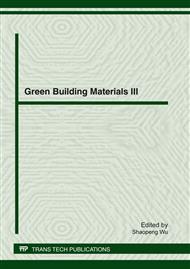[1]
where the n is crystallization index, the x is the amount of material transformed at the time t, and K is a crystallization kinetics parameter, which is according to the Arrhenius equation:
Google Scholar
[2]
where K0 is effective frequency factor, E is crystallization apparent activation energy, R is gas constant, and T is Kelvin temperature. According to the methods of thermal analysis and JMA equation, Kissnger[[]H. E. Kissinger, J.Res.Nat.Bur.Stand.57(1956)217. -[] KISSINGER H E. Reaction kinetics in differential thermal analysis [J]. Anal Chem, 19, 29 (11):1702–1706. ] proposed the formula:
DOI: 10.1021/ac60131a045
Google Scholar
[3]
In Kissinger equation, β is the heating rate, Tp is the peak temperature, and E is the crystallization apparent activation energy. The DSC traces of the two glass crystallized at heating rates of 5, 10,15 and 20℃/ min are shown in Figs.1 and 2. Values were calculated for the activation energies (E) using the Kissinger method (Eq. (3)). Plot of ln (Tp2/β) versus 1/Tp is expected to be linear, and from the slope of the plot, the activation energy (E) can be calculated. Experimental non-isothermal plots are showed in Figs.4 and 5. Both the A and B composition parent glasses have two exothermic peaks on the DSC traces. Using Kissinger method, the activation energy for glass A, the first crystalline phase is determined as 325.27 KJ/mol and the second crystalline phase is determined as 364.99 KJ/mol. The activation energy for the glass B for the first exothermic peak is 233.79KJ/mol and for the second exothermic peak is 273.85 KJ/mol. The glass B has lower activation energy. It contributed to the influence of mixed alkali effect, and adding K+ and Na+ at the same time can improve the crystal phase precipitation. Fig.4 Relationship between ln(Tp2/β)and 1/Tp from Fig.5 Relationship between ln(Tp2/β) and Kissinger equation of A composition glass 1/Tp from Kissinger equation of B composition glass In the condition of the crystallization activation energy E is known, the crystallization index (n) can be calculated by Augis–Bennett equation [[] AUGIS I A,BENNETT J E.Calculation of the aroma parameters for heterogeneous solid state reactions using a modification of the Kissinger method[J].J Therm Analy,1978,13(11): 283–292. ]:
Google Scholar
[4]
The △T is the FWHM of exothermic peaks in DSC traces. According to the solid state phase transformation theory, n=3 shows that the crystallization of glass for the bulk or three-dimensional crystallization; n=2 shows that the glass crystallization for two-dimensional crystallization; n=1 shows that the surface crystallization. The crystallization index (n) is calculated and summarized in table 3[[] YIN Hairong, Lv Chengzhen, LI Hui, et al. J Funct Mater, 2009, 40 (1):92–96. -[] R.Iordanova,E.Lefterova,I.Uzunov,D.Klissurshi,J.Therm.Anal.Calorim.70 (2002)393–40. ]. Table. 3 Crystallization index n of MAS glass at different heating rates Crystallization index
Heating rate/(K·min-1)
Average value
5
10
15
20
nA1
2.22
2.08
1.93
1.78
1.99
nA2
2.88
2.56
2.14
2.31
2.47
nB1
2.86
2.56
2.42
2.46
2.58
nB2
2.97
2.29
2.33
2.40
2.50
nA1,B1 ---Crystallization index of the composition A or B glass with spinel crystalline phase. nA2,B2--- Crystallization index of the composition A or B glass with SiO2 crystalline phase. The results show that: the average value of nA1 =1.99 with spinel crystal, nA2=2.47 with SiO2 crystal in composition A glass; the average value of nB1=2.58 with spinel crystal, nB2=2.50 with SiO2 in composition B glass. Both the two compositions A and B glass have almost the same average value (n) with SiO2. However, the average value m with spinel crystal in composition A glass is close to 2, and the average value (n) with SiO2 crystal is more close to 3. By adding K+, the glass ceramics with spinel as main crystal phase have the trend to change the crystal phase precipitation mode from two-dimensional to bulk crystallization. Conclusions From the experimental results, the following conclusions can be drawn: 1) The MAS transparent glass-ceramic with TiO2+ZrO2 as nucleating agents have been prepared. The DSC traces of glasses have two exothermic peaks. And the parent glass precipitated spinel and SiO2 in sequence during heat treated. 2) Values calculated for activation energies using the Kissinger method, as to glass A, the first crystalline phase is determined as Ep1(A)=325.27KJ/mol, and the second crystalline phase is determined as Ep2(A)=364.99KJ/mol; as to glass B, the Ep1(B)=233.79KJ/mol, Ep2(B)=233.79KJ/mol. 3) The average crystallization index nA1=1.99 with spinel crystal in composition A for the two-dimensional crystallization, and nB1=2.58 with spinel crystal in composition B more tending to bulk crystallization. References
Google Scholar


